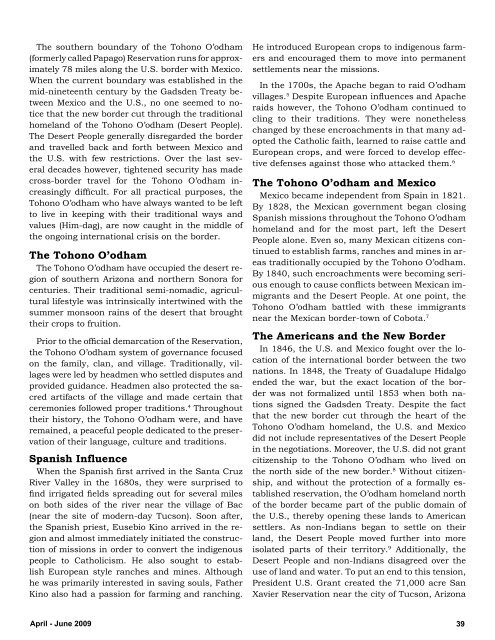Military Intelligence Professional Bulletin - Federation of American ...
Military Intelligence Professional Bulletin - Federation of American ...
Military Intelligence Professional Bulletin - Federation of American ...
You also want an ePaper? Increase the reach of your titles
YUMPU automatically turns print PDFs into web optimized ePapers that Google loves.
The southern boundary <strong>of</strong> the Tohono O’odham<br />
(formerly called Papago) Reservation runs for approximately<br />
78 miles along the U.S. border with Mexico.<br />
When the current boundary was established in the<br />
mid-nineteenth century by the Gadsden Treaty between<br />
Mexico and the U.S., no one seemed to notice<br />
that the new border cut through the traditional<br />
homeland <strong>of</strong> the Tohono O’odham (Desert People).<br />
The Desert People generally disregarded the border<br />
and travelled back and forth between Mexico and<br />
the U.S. with few restrictions. Over the last several<br />
decades however, tightened security has made<br />
cross-border travel for the Tohono O’odham increasingly<br />
difficult. For all practical purposes, the<br />
Tohono O’odham who have always wanted to be left<br />
to live in keeping with their traditional ways and<br />
values (Him-dag), are now caught in the middle <strong>of</strong><br />
the ongoing international crisis on the border.<br />
The Tohono O’odham<br />
The Tohono O’odham have occupied the desert region<br />
<strong>of</strong> southern Arizona and northern Sonora for<br />
centuries. Their traditional semi-nomadic, agricultural<br />
lifestyle was intrinsically intertwined with the<br />
summer monsoon rains <strong>of</strong> the desert that brought<br />
their crops to fruition.<br />
Prior to the <strong>of</strong>ficial demarcation <strong>of</strong> the Reservation,<br />
the Tohono O’odham system <strong>of</strong> governance focused<br />
on the family, clan, and village. Traditionally, villages<br />
were led by headmen who settled disputes and<br />
provided guidance. Headmen also protected the sacred<br />
artifacts <strong>of</strong> the village and made certain that<br />
ceremonies followed proper traditions. 4 Throughout<br />
their history, the Tohono O’odham were, and have<br />
remained, a peaceful people dedicated to the preservation<br />
<strong>of</strong> their language, culture and traditions.<br />
Spanish Influence<br />
When the Spanish first arrived in the Santa Cruz<br />
River Valley in the 1680s, they were surprised to<br />
find irrigated fields spreading out for several miles<br />
on both sides <strong>of</strong> the river near the village <strong>of</strong> Bac<br />
(near the site <strong>of</strong> modern-day Tucson). Soon after,<br />
the Spanish priest, Eusebio Kino arrived in the region<br />
and almost immediately initiated the construction<br />
<strong>of</strong> missions in order to convert the indigenous<br />
people to Catholicism. He also sought to establish<br />
European style ranches and mines. Although<br />
he was primarily interested in saving souls, Father<br />
Kino also had a passion for farming and ranching.<br />
He introduced European crops to indigenous farmers<br />
and encouraged them to move into permanent<br />
settlements near the missions.<br />
In the 1700s, the Apache began to raid O’odham<br />
villages. 5 Despite European influences and Apache<br />
raids however, the Tohono O’odham continued to<br />
cling to their traditions. They were nonetheless<br />
changed by these encroachments in that many adopted<br />
the Catholic faith, learned to raise cattle and<br />
European crops, and were forced to develop effective<br />
defenses against those who attacked them. 6<br />
The Tohono O’odham and Mexico<br />
Mexico became independent from Spain in 1821.<br />
By 1828, the Mexican government began closing<br />
Spanish missions throughout the Tohono O’odham<br />
homeland and for the most part, left the Desert<br />
People alone. Even so, many Mexican citizens continued<br />
to establish farms, ranches and mines in areas<br />
traditionally occupied by the Tohono O’odham.<br />
By 1840, such encroachments were becoming serious<br />
enough to cause conflicts between Mexican immigrants<br />
and the Desert People. At one point, the<br />
Tohono O’odham battled with these immigrants<br />
near the Mexican border-town <strong>of</strong> Cobota. 7<br />
The <strong>American</strong>s and the New Border<br />
In 1846, the U.S. and Mexico fought over the location<br />
<strong>of</strong> the international border between the two<br />
nations. In 1848, the Treaty <strong>of</strong> Guadalupe Hidalgo<br />
ended the war, but the exact location <strong>of</strong> the border<br />
was not formalized until 1853 when both nations<br />
signed the Gadsden Treaty. Despite the fact<br />
that the new border cut through the heart <strong>of</strong> the<br />
Tohono O’odham homeland, the U.S. and Mexico<br />
did not include representatives <strong>of</strong> the Desert People<br />
in the negotiations. Moreover, the U.S. did not grant<br />
citizenship to the Tohono O’odham who lived on<br />
the north side <strong>of</strong> the new border. 8 Without citizenship,<br />
and without the protection <strong>of</strong> a formally established<br />
reservation, the O’odham homeland north<br />
<strong>of</strong> the border became part <strong>of</strong> the public domain <strong>of</strong><br />
the U.S., thereby opening these lands to <strong>American</strong><br />
settlers. As non-Indians began to settle on their<br />
land, the Desert People moved further into more<br />
isolated parts <strong>of</strong> their territory. 9 Additionally, the<br />
Desert People and non-Indians disagreed over the<br />
use <strong>of</strong> land and water. To put an end to this tension,<br />
President U.S. Grant created the 71,000 acre San<br />
Xavier Reservation near the city <strong>of</strong> Tucson, Arizona<br />
April - June 2009 39
















